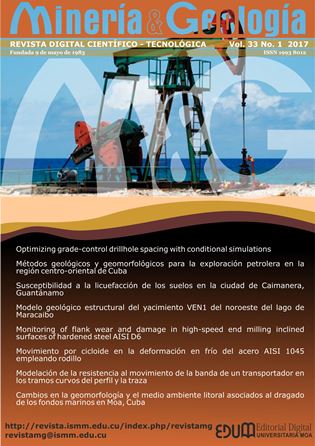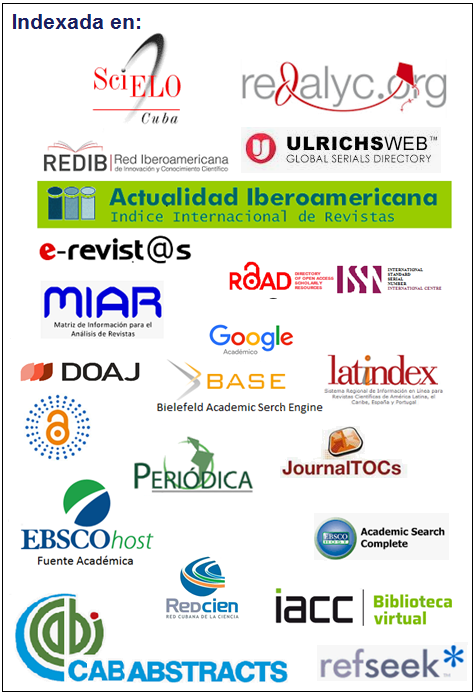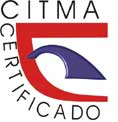Monitoring of flank wear and damage in high-speed end milling inclined surfaces of hardened steel AISI D6
Keywords:
milling, monitoring, inclined surfaces, wear, mechanism of damage, cutting force.Abstract
Cutting tool condition monitoring system in the industry is mainly used to detect tool wear, breakage and chatter on the tool. In this paper, tool wear with two inclination surfaces angles was investigated in end milling inclined surface using cutting force signals. This study is focused in the time domain radial force amplitude analysis and Root Mean Square (RMS) values for tool wear monitoring in milling process. The RMS value of the radial cutting force is increased with the flank wear and inclination angle increases. The analysis of the RMS values of the radial cutting force can be effectively used for the tool wear progression monitoring during milling operations. It was confirmed that in end milling inclined surface the predominant mechanism of damage is adhesive–abrasive.Downloads
References
ANTIĆ, A.; ŠIMUNOVIĆ, G.; ŠARIĆ, T.; MILOŠEVIĆ, M. & FICKO, M. 2013: A model of tool wear monitoring system for turning. Tehnicki Vjesnik 20(2): 247–254. Consulted: 10 Sept 2016. Available in: https://www.researchgate.net/publication/285539042_A_model_of_tool_wear_monitoring_system_for_turning
ALTINTAS, Y. 2012: Manufacturing automation: metal cutting mechanics, machine tool vibrations, and CNC design. Second Edition. Cambridge University, New York.
CAMPA, F. J.; LÓPEZ DE LACALLE, L. N. & CELAYA, A. 2011: Chatter avoidance in the milling of thin floors with bull-nose end mills: Model and stability diagrams. International Journal of Machine Tools and Manufacture 51: 43-53. Consulted: 29 Oct 2016. Available in: http://fulltext.study/preview/pdf/784497.pdf
CHILDS, T.; MAEKAWA, K.; OBIKAWA, T. & YAMANE, Y. 2000: Metal Machining. Theory and Applications. First Edition. Hodder Headline Group, London.
DE OLIVEIRA, A. J. 2007: Análise do desgaste de ferramentas no ferramentas no Fresamento com Alta Velocidade de aços endurecidos. Doctoral thesis. Universidade Estadual de Campinas. Campinas. SP. Brasil. Consulted: 30 Oct 2016. Available in: http://www.bibliotecadigital.unicamp.br/document/?code=vtls000415721
DINIZ, A. E.; MARCONDES, F. C. & COPPINI, N. L. 2010: Tecnologia da usinagem dos metais. Sétima edição. Editora Artileber Ltda, São Paulo.
GROTE, K. H. & ATONSONS, E. K. 2009: Handbook of mechanical engineering. Springer, New York.
JOZIĆ, S.; BAJIC, D. & TOPIC, S. 2012: Flank wear in down and up milling. Annals of DAAAM for 2012 & Proceedings of the 23rd International DAAAM Symposium 23(1): 0251-0254. Consulted: 1 Sept 2016. Available in: http://www.daaam.info/Downloads/Pdfs/proceedings/proceedings_2012/0251_Jozicatal.pdf
JOZIĆ, S.; LELA, B. & BATIĆ, D. 2014: A New Mathematical Model for Flank Wear Prediction Using Functional Data Analysis Methodology. Hindawi Publishing Corporation. Advances in Materials Science and Engineering 2014 (ID 138168): 2-8. Consulted: 12 Sept 2016. Available in: https://www.hindawi.com/journals/amse/2014/138168/abs/
KITAN, H. S.; KADHIM, B. I. & ABDULRAZZAQ, S. A. 2011: Cutting Forces Prediction in Ball End Milling. Engineering and Technology Journal 29(9): 1774-1789. Consulted: 27 Feb 2016.
KLOCKE, F.; ARNTZ, K.; CABRAL, G. F.; STOLORZ, M. & BUSCH. M. 2011: Characterization of tool wear in high-speed milling of hardened powder metallurgical steels. Hindawi Publishing Corporation Advances in Tribology 2011 (Article ID 90648): 2-13. Consulted: 23 Oct 2016. Available in: https://www.hindawi.com/journals/at/2011/906481/
KWON, Y. & FISCHER, G. W. 2003: A novel approach to quantifying tool wear and tool life measurements for optimal tool management. International Journal of Machine Tools and Manufacture 43(4): 359–368. Consulted: 28 Jan 2016. Available in: https://www.researchgate.net/publication/245096213_A_novel_approach_to_quantifying_tool_wear_and_tool_life_measurements_for_optimal_tool_management
LAJIS, M. A.; KARIM, A. N. M.; AMIN, A. K. M. N.; HAFIZ, A. M. K. & TURNAD, L. G. 2008: Prediction of tool life in end milling of hardened steel AISI D2. European Journal of Scientific Research 21(4): 592–602. Consulted: 10 Sept 2016. Available in: http://irep.iium.edu.my/26853/1/TL_Mill_D2_%238.pdf
ÖZEL, T.; KARPAT, Y.; FIGUEIRA, L. & DAVIM, J. P. 2009: Modeling of surface finish and tool wear in hard turning of AISI D2 steel using ceramics wiper inserts. Journal of Materials Processing Technology. 209: 5448–5455. Consulted: 11 March 2016. Available in: https://pdfs.semanticscholar.org/186f/21eae72eb48efeae1be2ea840d3438126c37.pdf
PIOTROWIAK, R.; SCHULER, V.; SCHRUFF, I. & SPIEGELHAUER, C. 2004: Spruhkompaktierte Hochleistungs-Werkzeugstahle. HTM Zeitschrift fur Werkstoffe, Warmebehandlung und Fertigung 59(6): 423–431. Consulted: 27 Oct 2016. Available in: http://www.hanser-elibrary.com/doi/pdf/10.3139/105.100315
SÁNCHEZ, Y.; DINIZ, A. E.; MARIÑO, M. & SANABRIA, F. 2016: Influencia del material del portaherramientas en la estabilidad dinámica del fresado de acero endurecido AISI D6. Revista Iberoamericana de Ingeniería Mecánica 20(1): 73-85.
SIVASAKTHIVEL, P. S.; VELMURUGAN, V. & SUDHAKARAN, R. 2010: Prediction of vibration amplitude from machining parameters by response surface methodology in end milling. International Journal of Advanced Manufacturing Technology 2: 1780–1789. Consulted: 23 Nov 2016. Available in: https://www.researchgate.net/publication/50281790_Prediction_of_tool_wear_from_machining_parameters_by_response_surface_methodology_in_end_milling
TRENT, E. M. & WRIGHT, P. K. 2000: Metal Cutting. Butterworths. London, Great Britain.
TONSHOFF, H. K.; ARENDT, C. & BEN-AMOR R. 2000: Cutting of hardened steel. Annals of the CIRP 49(2): 547–566. Consulted: 3 Sept 2016. Available in: https://www.researchgate.net/publication/229136898_Cutting_of_Hardened_Steel
TÜYSUZ, O. 2012: Prediction of cutting forces in three and five-axis ball-end milling with tool indentation effect. Master's Thesis. The University of British Columbia. Vancouver, Canada. Consulted: 3 Sept 2016. Available in: https://open.library.ubc.ca/media/download/pdf/24/1.0072530/2/565
VOPÁT, T.; PETERKA, J. & KOVÁČ, M. 2014: The tool life of ball nose end mill depending on the different types of ramping. Faculty of Materials Science and Technology in Trnava. Slovak University of Technology in Bratislava 22(Special Number): 115–121. Consulted: 1 Sept 2016. Available in: http://www.mtf.stuba.sk/docs/doc/casopis_Vedecke_prace/33SN/4-Vopat.pdf
WOJCIECHOWSKI, S.; TWARDOWSKI, P. & PELIC, M. 2014: Cutting forces and vibrations during ball end milling of inclined surfaces. 6th CIRP International Conference on High Performance Cutting HPC 2014. PROCEDIA CIRP 14: 113-118. Consulted: 12 April 2016. Available in: https://www.researchgate.net/publication/263049465_Cutting_Forces_and_Vibrations_During_Ball_End_Milling_of_Inclined_Surfaces
Published
How to Cite
Issue
Section
- Authors retain copyright and guaranteeing the right magazine to be the first publication of the work as licensed under a Creative Commons Attribution-NonCommercial that allows others to share the work with an acknowledgment of the work's authorship and initial publication in this journal.
- Authors may establish separate supplemental agreements for the exclusive distribution version of the work published in the journal (eg, place it in an institutional repository or publish it in a book), with an acknowledgment of its initial publication in this journal.
- Authors are allowed and recommended to disseminate their work through the Internet (e.g., in institutional telematic archives or on their websites) before and during the submission process, which can produce interesting exchanges and increase citations of the published work. (See The effect of open access)




